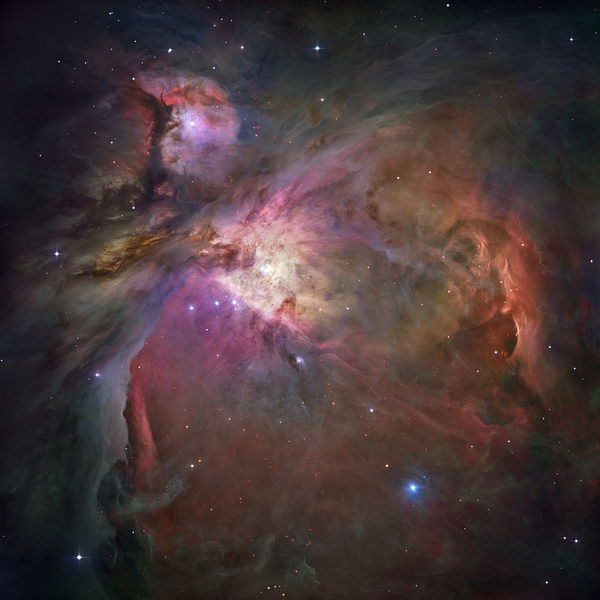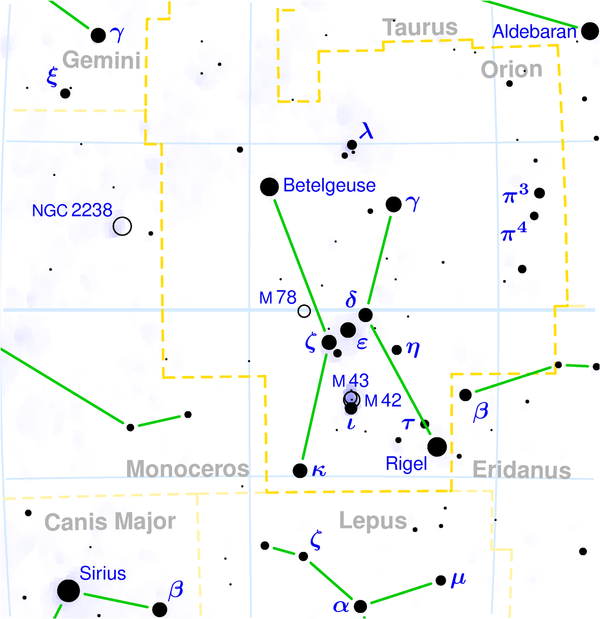2015年06月13日
天文(19)− メシエ天体(3)

Whirlpool Galaxy (M51A or NGC 5194). The smaller object in the upper right is M51B or NGC 5195. Credit: NASA/ESA
(旧暦4月27日)
天文(19)− メシエ天体(2)のつづき
かなり“おたく”の「板橋村だより」にメールを下さる方がいて、「世の中、物好きな方もいらっしゃるんだ!」と驚きながらも気を良くして、続きを書きだしています。
忙しい年末・年始および年度末・年度初めを過ごしていましたので、うっとうしい梅雨空の下、やっとその気になりましたことをお詫び申し上げます。
フランスの天文学者シャルル・メシエ(Charles Messier 、1730~1817)が彗星の探索に際して、彗星と紛らわしい103個の天体のカタログを作り、1781年から1784年にかけて発表したメシエ天体(Messier object)の内、愛称で呼ばれる29の天体について、今回はM40からM57 を紹介致しましょう。

このカタログでは、天体に関するメシエ自身の記述が観測の日付と共に記述されていますが、メシエは自分自身を三人称で呼んでいるのが特徴的です。
Messier: M40.
October 24, 1764. 40. 12h 11m 02s (182d 45' 30") +59d 23' 50"
Two stars very close together & very small, placed at the root of the tail of the Great Bear: One has difficulty to distinguish them with an ordinary telescope of 6 feet [FL]. While searching for the nebula above the back of Ursa Major, reported in the book Figures des Astres, and which is supposed to be for 1660 at 183d 32' 41" right ascension, & 60d 20' 33" northern declination, which Messier couldn't see, he has observed these two stars.
[観測日:1764年10月24日]
二つの星は互いにとても近く、非常に暗い。おおぐまのしっぽのつけ根に位置している。単純な6フィート屈折望遠鏡で見分けるのは難しい。”Figures des Astres”という本によると、おおぐま座の背の上にあって、1660年には赤経183°32′41″、赤緯60°20′33″にあったはずの星雲を捜している間に−メシエは結局これを見つけられなかったのだが−、彼はこの二重星を観測した。

Winnecke 4 double star
M40 はウィンネッケ4番星(Winnecke 4)として知られている二重星で、おおぐま座70番星の北東約0.5°、北斗七星のひしゃくの一部δ星(Megrez)の近くにあります。
1660年、ポーランドの天文学者ヨハネス・ヘヴェリウス(Johannes Hevelius;1611〜1687)が、「おおぐま座の背の上に星雲がある」と報告しましたが、現在では二重星以外の何者でもないということが広く受入れられています。

Johannes Hevelius、1611〜1687
[Hevelius: No. 1496]
Supra tergum nebulosa (above the back [of Ursa Major] there is a nebulosa [nebulous star]).
[actually this is not M40 but 74, 75 Ursae Major]

これは、ヨハネス・ヘヴェリウスが当時、「古くて欠陥のある装置」で観測したために、星雲に見えたのではないかということです。
メシエもヨハネス・ヘヴェリウスによって報告された座標に星雲を見つけようと試みましたが、間隔の狭い二重星しか確認できませんでした。彼はそれを星雲と間違えることはありませんでしたが、彗星と紛らわしいという理由からカタログに含めることにしました。
しかし、地球の歳差運動の影響により、ヨハネス・ヘヴェリウスが報告した星雲の位置が現在のおおぐま座74番星と一致していることから、やっかいなことになりました。
さて、1863年、ドイツの天文学者フリードリヒ・アウグスト・テオドール・ヴィネッケ(Friedrich August Theodor Winnecke、1835〜1897)は、ロシアのプルコバ天文台でこの位置に観測した二重星を報告しましたが、1966年、アメリカ合衆国のアマチュア天文家ジョン・H・マラス(?〜1975)は、メシエが観測しカタログに載せた天体が、1863年にフリードリヒ・アウグスト・テオドール・ヴィネッケにより再発見された二重星のウィンネッケ4番星であることを確認しています。

Friedrich August Theodor Winnecke、1835〜1897
Mallas (1966): Identification of M40
[From a letter by John H. Mallas to the Editor of Sky and Telescope, August 1966, p. 83]
Letter
Sir,
In the Messier catalogue of nebulae and clusters, as reprinted on the April 1966 issue, no description or position is given for M40, but a reference is provided to Owen Gingerich's statement of 1960 that this object is a pair of faint stars.
Which pair? Dr. Gingerich sent me this translation of Messier's original description, from Mémoires de l'Académie Royale des Sciences, 1771:
"The same night on October 24-25, [1764,] I searched for the nebula above the tail of the Great Bear, which is indicated in the book Figure of the Stars, second edition. Its position in 1660 was right ascension 183d 32' 41", declination 60d 20' 33". By means of this position, I found two stars very near each other and of equal brightness, about 9th magnitude, placed at the beginning of the tail of the Great Bear. One can hardly distinguish them in an ordinary (nonachromatic) refractor of 6 feet (length). Their position is 182 deg 45' 30", +59 deg 23' 50". We presume that Hevelius mistook these two stars for a nebula."
The latter position, precessed from 1765 to 1950, is 12h 20m.0, +58d 22', which agrees almost exactly with the double star Winnecke 4, magnitudes 9.0 and 9.3, separation 49 seconds of arc. This is an easy pair in my 4-inch refractor at 25x. It was discovered by A. Winnecke in 1863 at Pulkowo Observatory.
Clearly, M40 is identical with Winnecke 4. But the Hevelius object is the 5th-magnitude star 74 Ursae Majoris, more than one degree away, as reference to his star catalogue will show.
JOHN H. MALLAS
5115 E. Tomahawk Trail
Scottsdale, Ariz. 85251

The entire Orion Nebula in visible light.
Messier: M42.
March 4, 1769. 42. 5h 23m 59s (80d 59' 40") -5d 34' 06"
Position of the beautiful nebula in the sword of Orion, around the star Theta which it contains [together] with three other smaller stars which one cannot see but with good instruments. Messier has entered into the great details in this great nebula; he has created a drawing, made with the greatest care, which one can see in the Memoirs of the Academy for 1771, plate VIII. It was Huygens who discovered it in 1656: it has been observed since by many astronomers. Reported in the English Atlas.
[観測日:1769年3月4日]
オリオンの剣の中、θ星のまわりにある美しい星雲のある場所。θ星は星雲の中にあって、三つのより淡い星とともにある。これらの三つの星は、性能の良い機材を用いなければ見ることはできない。メシエはこの大星雲について、非常に詳細に調べた。彼は非常に注意深くスケッチをしたが、それは“Mémoires de l’Académie 1771” 図版 VIII に見ることができる。ホイヘンスは1656年にこれを発見し、その後多くの天文学者が観測してきた。イギリスの” Atlas Céleste”に報告されている。

肉眼による天体観測において最も大きな受け入れがたい結論の一つは、天文学の父とも称される近世イタリアの天文学者ガリレオ・ガリレイ(Galileo Galilei、1564〜1642)が、このオリオン大星雲に気づいていなかったということです。
全天で最も雄大で、肉眼でも見える星雲の一つでもあり、最も有名で光り輝く星座の一つの中の、最も知られた星群(オリオンの三つ星)にぶら下がっているこの大星雲を、かのガリレオが見のがしていたということは、非常な謎とされています。
オリオン星雲は蛍光を発する巨大なガス星雲で、ほとんどが水素、わずかにヘリウム、炭素、窒素、酸素を含み、40光年の直径を持っています。
その中心部には、トラペジウム (Trapezium;台形)と呼ばれる散開星団があり、オリオン大星雲の星生成領域で生まれた比較的若い星による星団です。
4つの明るい星には赤経の順に、A (6.73等) 、B (7.96等) 、C (5.13等) 、D (6.71等) の符号が付けられており、AとBは共通重心の周りを回る2つの星が互いの光を覆い隠し合うことによってみかけの明るさが変わる食変光星として知られています。 続きを読む



